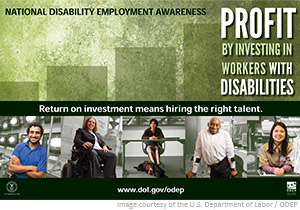
In part 1 of our series, we discussed the importance of C-Suite leadership and the need for the executive team to appoint an internal ADA/ADAAA process owner – someone to be responsible for leading program development. Often, this leader's first task is to identify key stakeholders for involvement in designing the process.
Identifying the right stakeholders to participate in program development is very important to success. Broad stakeholder input can ensure that ADA/ADAAA processes are effective in meeting overall business needs. These stakeholders can include:
- HR business partners (those who work directly with operations)
- Labor relations
- Employee benefits
- Risk management/workers' compensation
- Operations managers/supervisors
- Employee health services
- Internal safety/ergonomic partners
- HR employment/recruitment
Develop and document the written administrative program, including process flows and roles and responsibilities. The stakeholder team can help to develop underlying detail for the administrative processes, with sensitivity to practical issues. Important steps in program development include:
- Create an outline of the differing roles and responsibilities of the interactive process—including the employee's responsibilities. Also, include development of process tools, such as an employee questionnaire and forms for obtaining medical information and employee capabilities. It may be useful to summarize the interactive process with a checklist of essential steps.
- Ensure that the process is compliant, that relevant HR policies are referenced/footnoted and that terminology is defined. An accommodation may not occur frequently for some supervisors/managers involved, so having good reference materials is a plus. Also, identify internal expert resources for quick personal assistance, including their contact information.
- Outline the key considerations and criteria that will guide the interactive process, such as how to structure decision-making and any case elements that require escalation with others, e.g. legal, HR senior executives, labor relations, operations managers, employee health services, etc. Identify which cases require sign-off for finalizing the employer offer of accommodation. In some organizations, sign-off may be needed only if the accommodation involves the potential for undue business hardship or for creating union or labor relations issues. In other organizations, sign-off on all accommodation cases is preferred.
Identify needs for ongoing training, communications, data collection and tracking. Develop ongoing education/communications to ensure that supervisors and managers understand how to work with an employee who has returned to work with a job accommodation. Especially important is guidance for supervisors in addressing performance issues once the employee is back to work. Employee performance and productivity are important to evaluate within the context of the job accommodation. There may be an additional step needed for understanding if the disability may be affecting performance. If so, further review of the job accommodation and any modified duties may be needed. Identifying HR coaching resources may be useful to assist supervisors when these issues arise.
Ensure that a tracking system for ADA/ADAAA claims is in place and identify up front the data to be collected. Tracking can improve oversight for any needed course correction and could be important if an employer's processes or compliance with the law is challenged. Summary data is also very important for trend and results communications to the C-Suite. Some vendors offer tracking and reporting, usually as an ancillary service or, perhaps, as a standalone software package.
In part 3, our last blog in this series, we will discuss using outside specialty resources to reduce the burden on the employer by supplying expertise in job accommodation and return to work, as well as coordinating part of the interactive process and providing tracking and reporting of an employer's ADA claims and trends. Until then, please share your comments and questions with us in the comments.
Denise Fleury, SVP, Disability and Absence Management